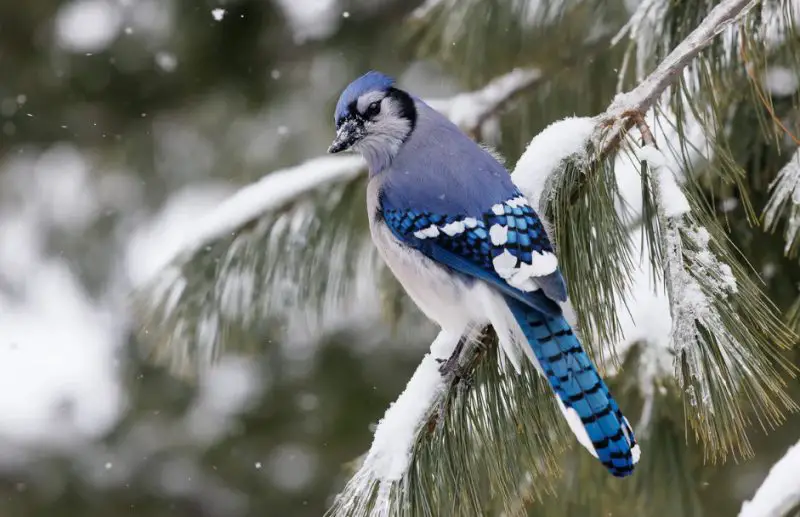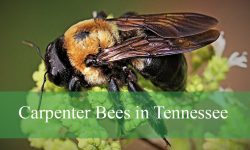Blue jays stand out as exceptionally clever and versatile birds across North America, though their winter survival tactics are still surprisingly little observed. In Michigan, where winters can be long, snowy, and nutritionally challenging, blue jays rely on an advanced food-caching system that showcases remarkable memory, planning, and ecological awareness. Far from being simple backyard visitors, these birds demonstrate behaviors that reflect strong evolutionary refinement and a skill set rivaling that of corvids such as crows and ravens.
Understanding how blue jays store food requires examining their cognitive abilities, environmental interactions, and winter physiology. Michigan’s forests, suburbs, and mixed agricultural areas offer both opportunity and hardship for these birds. As temperatures drop and insect populations decrease, food caching becomes not just a convenience but a necessity for survival.
This article explores the sophisticated methods blue jays use to prepare for winter, revealing the biology, behavior, and ecological significance behind their caching strategies.
Michigan’s Winter Challenges for Blue Jays

Why Michigan’s Climate Demands Advanced Food Storage
Michigan winters are characterized by prolonged cold periods, deep snow cover, and limited food availability. Insects—the main protein source for many birds—become scarce, while acorns and nuts drop early in the season and must be collected rapidly.
These environmental conditions pressure blue jays to develop robust caching strategies. They begin storing food in late summer and continue into early winter, anticipating the months when food resources vanish.
As snow accumulates across forests and urban landscapes, blue jays rely heavily on stored caches, moving between known locations with incredible precision.
Landscape Variation Influences Where Jays Cache Their Food
Michigan’s diverse terrain—from dense oak-hickory woods to suburban parks and farmland—creates varied caching opportunities. Blue jays adjust their behavior according to habitat type, selecting locations that provide concealment, low predation risk, and stable ground conditions.
Forested areas offer leaf litter and tree crevices ideal for hiding acorns. Suburban areas provide mulch beds, ornamental shrubs, and soil patches around homes and gardens that can be efficiently used for caching.
These environmental differences shape how blue jays distribute their food, influencing the distance, depth, and frequency of their caching trips.
Winter Predators Shape the Jays’ Caching Behavior
Michigan hosts numerous predators—hawks, owls, foxes, and even domestic cats—that influence how blue jays behave while storing food. Caching must be fast, discreet, and strategically placed to avoid detection.
If predators are present, jays modify their caching performance by using quicker burial techniques or choosing hidden spots away from open ground. They also reduce vocalizations to prevent drawing attention.
Predator pressure adds an extra layer of complexity to their winter-preparation strategy.
The Science Behind Blue Jay Food Caching
The Role of Spatial Memory and Cognitive Mapping
Blue jays possess exceptional spatial memory. They remember thousands of individual cache locations using cognitive maps—a mental representation of surrounding landmarks, textures, and directions.
This memory is not random. Jays use visual cues such as tree shapes, root patterns, rock placement, and even human structures to track stored food.
Studies show that jays can remember cache sites for several months, revisiting them precisely even after heavy snowfall, relying on spatial cognition that rivals some mammals.
Sensory Adaptations That Aid Food Storage
Blue jays use their sharp eyesight to evaluate caching sites and their stout bills to manipulate acorns and nuts efficiently. Their bill shape allows them to transport multiple acorns, sometimes carrying one in the mouth and two in the throat pouch.
They also possess tactile sensitivity that helps them judge soil firmness, ensuring buried food is not easily retrieved by other animals.
These sensory traits directly support caching success in Michigan’s changing seasonal environment.
How Jays Decide Which Foods to Store
Blue jays prioritize foods that provide high caloric value and long-term stability. Acorns sit at the top of their list, particularly those from white oak species whose lower tannin content makes them more palatable.
They also store beechnuts, hazelnuts, sunflower seeds, peanuts, and occasionally small kernels of corn. Foods prone to spoiling are rarely cached unless temperatures are low enough to preserve them.
This selective behavior ensures that energy-rich, durable foods are always available during the harshest periods.
Methods Blue Jays Use to Cache Food
Scatter-Hoarding: The Most Common Strategy
Blue jays rely on scatter-hoarding, hiding individual items across hundreds or thousands of locations. This approach limits losses from predators or competing animals, since discovering a single cache does not jeopardize the entire food supply.
Scatter-hoarding also reduces the risk of spoilage by exposing each saved item to unique microconditions, such as varied light exposure or soil moisture.
This strategy requires sophisticated memory and decision-making, both of which blue jays demonstrate with remarkable consistency.
Using Tree Bark, Soil, and Leaf Litter for Concealment
Blue jays use multiple natural substrates to hide food. They press acorns into bark crevices, bury nuts under soil or leaf litter, and wedge seeds beneath plant roots.
Each substrate offers different benefits. Bark caches are difficult for ground predators to find, while soil caches offer insulation and protection from freezing. Leaf litter disguises disturbed ground, making it less likely scavengers will detect buried food.
Their ability to exploit diverse microhabitats contributes to their winter success.
Multi-Step Caching Involving False Hiding
Blue jays sometimes perform deceptive caching behavior, especially when other jays or squirrels are nearby. They may pretend to bury a nut—scratching the soil without actually depositing anything—before flying off to hide the food elsewhere.
This “false caching” is a sign of advanced cognitive capability, suggesting jays are aware of being observed and intentionally misleading competitors.
Such strategic deception is particularly important in Michigan’s crowded winter feeding grounds.
Re-Caching: Moving Food When Threats Increase
If blue jays sense that a particular location has become too risky—due to predators, competing animals, or human disturbance—they may retrieve stored food and move it to a safer spot.
Re-caching requires excellent short-term memory and rapid decision-making. Blue jays often perform this behavior in early winter when high predator activity coincides with the last major caching efforts.
Re-caching also allows jays to optimize proximity to reliable winter shelter.
Ecological Impacts of Blue Jay Caching
The Blue Jay as a Forest Regenerator
Blue jays inadvertently plant thousands of acorns each year, many of which they never retrieve. These acorns can germinate into oak seedlings, making blue jays essential contributors to Michigan’s forest regeneration.
Their scatter-hoarding supports species such as white oak, red oak, and bur oak, influencing woodland composition for decades.
This ecological role has earned them recognition as one of the most influential seed dispersers in eastern North America.
Supporting Biodiversity Through Winter Food Storage
Because blue jays gather and distribute acorns across wide areas, they help maintain food resources for other animals. Leftover caches become winter supplies for squirrels, mice, and nuthatches.
This shared benefit supports a complex winter food web, especially during harsh snow periods when natural resources are minimal.
Blue jay caching indirectly strengthens ecosystem resilience.
How Jays Balance Food Storage With Daily Energy Needs
Caching demands energy: flying long distances, transporting heavy acorns, and burying food all require calories. Blue jays must balance immediate needs with long-term security.
They feed heavily during caching seasons, taking advantage of abundant autumn nuts and seeds. This allows them to store food vigorously while maintaining body condition for winter.
Energy management is a key aspect of their survival strategy.
Winter Retrieval Strategies and Daily Behaviors
Navigating Heavy Snow to Recover Stored Food
Michigan’s deep snow cover presents challenges, but blue jays are adept at locating caches beneath several inches of snow. They use precise memory, along with subtle visual cues, to find buried food.
When snow hardens into crust, jays may chip through or focus on caches stored in elevated places such as tree bark or branch junctions.
Their persistence ensures reliable food availability throughout the winter season.
How Jays Allocate Which Caches to Visit First
Not all caches are equal. Blue jays prioritize fresh, high-energy items early in winter while saving durable reserves such as acorns for mid-to-late winter.
This allocation strategy shows advanced planning: jays appear to understand which foods degrade quickly and which remain intact for months.
Their retrieval pattern reflects a balance of nutritional efficiency and risk management.
Social Dynamics Influence Cache Retrieval
Jays often move in small family groups during winter. Group dynamics influence when and how caches are retrieved. Dominant individuals may access prime caches first, while younger birds rely on lower-ranked locations.
Communication plays a role too. Jays vocalize to signal threats, helping group members avoid risky feeding zones.
These social strategies are especially valuable during deep winter when efficiency determines survival.
Adaptations That Support Winter Survival in Michigan
Plumage and Body Fat for Insulation
Blue jays grow dense winter plumage that traps warm air close to the body. By fluffing feathers, they increase insulation during cold snaps.
They also accumulate fat reserves in fall, which act as emergency energy sources during blizzards when accessing caches becomes difficult.
These physiological adaptations complement their behavioral strategies.
Winter Territory Selection Based on Food Security
Blue jays select winter territories that offer a combination of shelter, food access, and predator protection. Areas with evergreen cover—white pine, hemlock, spruce—provide ideal winter roosts.
These territories often overlap with their caching zones, limiting travel distance and energy expenditure during severe weather.
Territory selection reflects careful balancing of environmental factors.
Adaptations That Allow Jays to Break Frozen Food
When cached items freeze solid, blue jays use their strong bills to crack through the outer layer. They may also pound items against hard surfaces such as rocks or branches to access the edible interior.
This adaptation is especially important for nuts cached late in the season when temperatures drop sharply.
Without this ability, many winter food stores would be unusable.
FAQs About How Blue Jays Store Food for Michigan Winters
How many acorns can a blue jay store each year?
A single blue jay can store thousands of acorns annually, often transporting several at once to scattered cache sites.
Do blue jays remember all their cache locations?
They remember most of them using spatial memory, though unrecovered caches often germinate into new trees.
What foods do blue jays prefer to store?
Acorns, beechnuts, peanuts, sunflower seeds, and occasionally corn kernels.
Do blue jays steal from other birds’ caches?
Yes, and they use deceptive caching to prevent others from stealing their own.
How do blue jays find food under deep snow?
They rely on long-term memory and visual landmarks, even when snow conceals the ground.
Why do blue jays cache food instead of migrating?
Caching allows them to survive Michigan winters without long-distance migration.
Are all blue jays in Michigan year-round residents?
Many are residents, but some migrate short distances depending on food availability.
Do blue jays ever guard their caches?
Rarely. They rely on scatter-hoarding rather than guarding.
Conclusion
Blue jays demonstrate an extraordinary combination of memory, intelligence, and environmental awareness that allows them to survive Michigan’s harsh winters. Their food-caching behavior reflects the advanced evolutionary adaptations of the corvid family, blending spatial cognition, sensory prowess, and ecological strategy. As they scatter acorns across forests and neighborhoods, they contribute to the regeneration of Michigan’s woodlands while ensuring their own winter security.
Understanding the blue jay’s winter tactics provides insight into the complex behavioral ecology of this species and highlights their importance within the state’s ecosystems. Their ability to plan, store, and recall thousands of hidden food reserves makes them one of Michigan’s most remarkable winter survivors.






